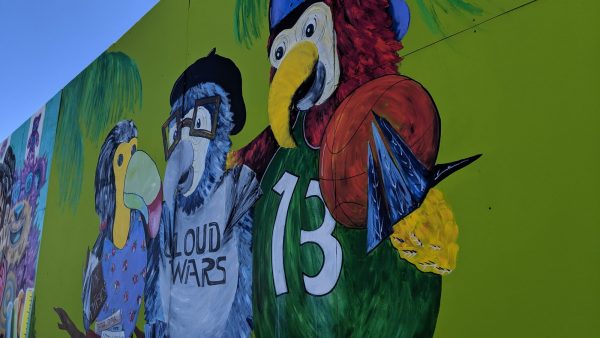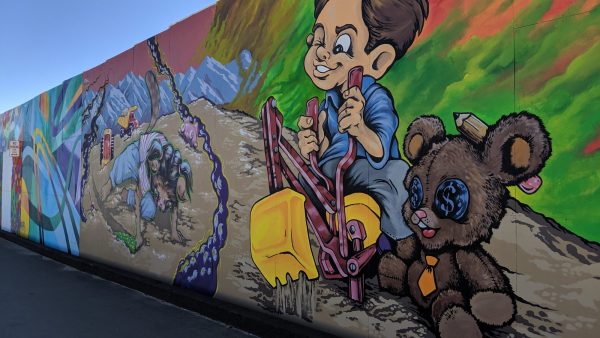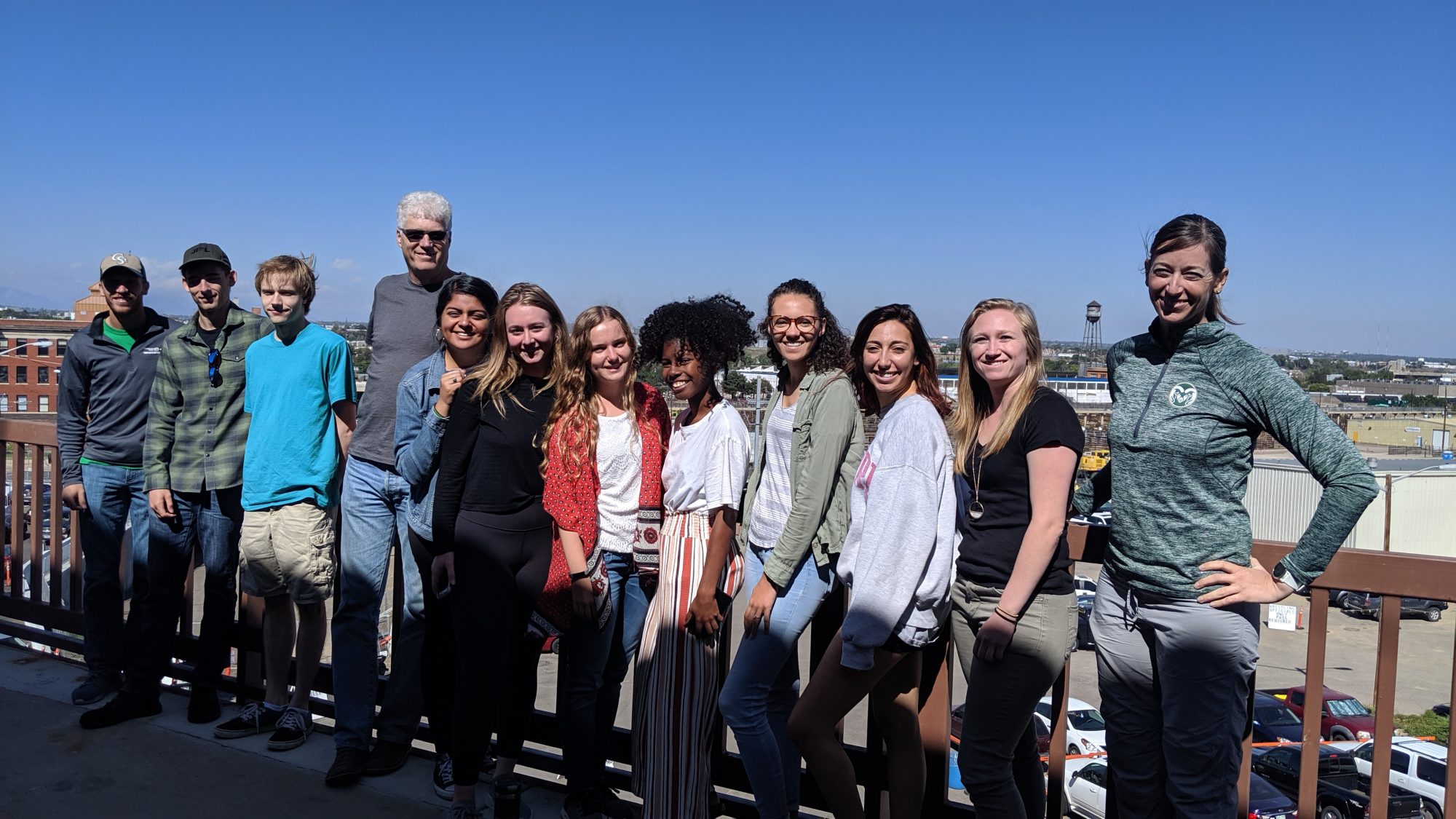Bluebird skies frame the mural-adorned plywood wall that defines the southern border of Swansea Elementary School in Denver. The 700-foot-long wall shields parents, children, and educators from the material effects of sinking a two-mile portion of I-70 below grade. The work is part of a 10-mile, four-year expansion project to upgrade the congested and aging infrastructure. In 2018, Colorado Department of Transportation selected 30 Denver-area artists to help transform the wall that separates the school from the I-70 construction zone into a “fun and safe space.”
The wall, and the construction on the other side, occupy the place where Swansea Elementary recess once took place. The murals depict wonder and intrigue with their colorful, larger-than-life-size paintings of basketball, social justice, and cartoon heroes at play. Most evoke cheerful innocence. One offers a sinister criticism of the wall’s existence.


Xochitl Ramirez, a senior double-majoring in social work and communication studies, walks the length of the wall with Dr. Greg Dickinson. Her classmates from “Communicating Urban Identities” walk and talk in groups, saunter alone snapping photos, and peer heads around the wall’s west end to view the expansive I-70 construction.
The small class – six communication studies majors and four economics majors – traveled to northeast Denver on a Saturday in late September to visit different redevelopment sites in the neighborhoods surrounding the existing National Western Complex located at I-70 and Brighton Boulevard. The 250-acre complex is being transformed into the National Western Center, which will include a new urban campus for the Colorado State University System.

By early afternoon students had already visited the future site of the NWC, speaking at length with Jocelyn Hittle, Senior Director for Colorado State University System’s Denver Programs and Sustainability, and walked the stacks inside the Elyria-Swansea Public Library one mile east. They hoped to tour The GrowHaus, a nonprofit indoor farm in Elyria-Swansea that seeks to create a healthy, equitable, and resident-driven neighborhood food system, but the center was unexpectedly closed for seasonal maintenance.
Earlier at lunch in the RiNo (River North) district located southwest of the Elyria-Swansea neighborhood, Ramirez shared with her fellow students that her close childhood friend, Karina, had grown up in Elyria-Swansea just one block from the stock show grounds.
“Her family had to move last year,” Ramirez said. Eminent domain had taken the family’s house for improvements to Brighton Boulevard, which borders Elyria-Swansea to the east and the NWC to the west.
Ramirez, who grew up to the east of Elyria-Swansea in the Montebello neighborhood, met Lydia through church. Their families were close friends. Ramirez spent a lot of her childhood at Lydia’s house.
As Ramirez walks the length of the wall with Dickinson she goes back in time to her childhood, but with difficulty. “I’m trying to remember what used to be here,” Ramirez tells Dickinson. “All I see is what’s here now.”
Ramirez stares into the construction site. The earth has been excavated well below grade. Pile drivers are frozen in time, waiting for Monday to resume the work of setting new foundation. Plans for the I-70 expansion include capping a section of the interstate to create a new urban greenspace.
“It’s like they dug up your memories,” Dickinson responds.
Ramirez nods and lifts her phone to photograph the construction site looking to the east and then the west. For now, the scene shows two vastly different realities separated by 6-inches of plywood. What you see depends on where you stand.
Space: Interdisciplinary learning
“Communicating Urban Identities” is the first course affiliated with a new College of Liberal Arts Undergraduate Research Academy (URA) called “Bridging the Rural-Urban Divide in Colorado.” The Institute for Learning and Teaching (TILT) at CSU started undergraduate research academies to create interdisciplinary research opportunities that address problems from different perspectives. According to TILT, educational research has shown that students who learn alongside faculty achieve higher rates of academic performance, retention, and entry into graduate and professional programs.
Greg Dickinson, communication studies professor and department chair, and Stephan Weiler, economics professor and director of the university’s Regional Economic Development Institute (REDI), developed “Bridging the Rural-Urban Divide in Colorado.” In the redevelopment of the National Western Center, they saw an opportunity to research issues of urban growth, rural constriction, and the forces in between that make, break, and re-create communities.
“Broadly, the URA and this first class asks undergraduate students to explore different ways of thinking about gentrification, affordable housing, communities in flux, and celebrating Colorado’s agricultural heritage while not erasing other histories and identities,” Dickinson says.
Dickinson introduces the new Undergraduate Research Academy "Bridging the Rural-Urban Divide in Colorado"
Dickinson has devoted his scholarly energy to advancing the rhetoric of place and space, a field within the communication studies discipline that investigates how the built environment informs identity, belonging, and memory. He has visited and studied cities, suburbs, coffee shops, malls, museums, and memorials to reflect on how individuals imagine and build the good life, search for authenticity, and construct public memory.
“The NWC and this URA are providing opportunities for students to study diversity, power, and community across divergent spaces,” Dickinson says.
1908 stock show grounds. Photo from the National Western Stock Show.
Place: National Western Center
In 1881 the Denver Union Stockyard Company was founded near the South Platte River parallel to three rail lines that connected Denver’s mineral and agricultural wealth to sites of commerce across the country. The livestock industry boomed. So did the construction of buildings, stock pens, and other affiliated infrastructure needed to support the daily operations of buying and selling cattle, sheep, and swine. Meat packing and ore smelter companies grew up adjacent the stockyards. The opportunity for employment attracted an influx of largely immigrant workers who would establish the Elyria, Swansea, and Globeville communities to the east and the west.
In 1906, the first “official” Western Livestock Show occurred under a circus big top tent. Its success demanded an annual gathering of buyers, sellers, and spectators, and in time, several dedicated stock show facilities to house events. Over the decades, the site of what became the National Western Stock Show (NWSS) would see ample changes, including the addition of the Denver Coliseum, the arrival of an elevated interstate, and the decline of daily livestock operations. But the annual stock show lived on.
By 2011 the NWSS had outgrown its facilities. An effort to redevelop the site advanced through the Denver Urban Renewal Authority. In 2013, multiple partners – the City of Denver, Colorado State University, the National Western Stock Show, History Colorado, and Denver Museum of Nature and Science – committed to creating an urban campus that would bring year-round programming to the site. In 2015 the City of Denver approved a master plan to transform the 250 acres into the National Western Center.
The vision of the NWC is breathtaking: eight new buildings with flexible and dedicated uses; new outdoor entertainment, exhibition, and gathering spaces; a bridge across the South Platte River; recreation trails and green spaces; and, the redevelopment of existing and historic facilities, such as the Livestock Exchange Building, Denver Coliseum, and original stock show arena.
In March 2020, CSU breaks ground on three buildings at the site: a center for water education, policy and innovation that includes flex space for other engagement and outreach activities; a center for food and agriculture discovery, research, education and production, which will house CSU Extension services; and, an animal health complex that will provide veterinary services, the Temple Grandin Equine Center, equine sports medicine and much more. The buildings are slated to open in 2022. The rest of the build-out of the entire NWC, including redevelopment of the existing stock show facilities (coliseum, historic arena, and expo hall – an area referred to as “The Triangle”), will take longer.
Finding voice
Communication Studies doctoral student Jordin Clark (M.A., ‘17) designed the “Communicating Urban Identities” course with mentorship from Dickinson and Weiler. In general, students spend the first half of class discussing and presenting reading assignments from each other’s disciplines. Students spend the remainder of class time in break-out discussions with their fellow majors. Economics students meet with graduate student Kit Deming, communication studies students with Clark. In this way, students are continually exposed to new concepts, thereby broadening their knowledge. But they also deepen their understanding by focusing on discipline-specific ideas.
Regardless of major, Clark wants students to critically engage with the relationship between place/space and power within a specific urban context: Denver, the NWC, and surrounding neighborhoods. She acknowledges that students from each discipline will think differently about what a place means and communicates. Take the process of gentrification.
“As a communication studies student I’m going to ask very different questions about the role and impact of gentrification than I will as an economics student,” Clark says. “How do the roots of an area change as some people are forced out and others move in? Who gets to stay? Who leaves? What does this say about a community? What are the tensions between identity and movement?”
Viewed through the lens of economics, gentrification asks equally valid questions, Clark says. For instance, is the area becoming (more) profitable? Are more people benefitting? Is water cleaner? Public transportation more available? Do grocery stores arrive?
Prior to the class she hadn’t thought about those questions. Her perspective was driven by effects from the discriminatory practice of redlining, a term used to describe the systematic denial of mortgage loans to people of color living in urban cities.
“You can see the suffering that happened predominantly to communities of color as they were pushed out of their homes,” Clark says. “But then thinking about gentrification today, if it’s become different, if we care a bit more about the people who live in the neighborhoods in question, look at the taxes and what they will support – if we understand the economics of it, we get a much more complicated picture of what gentrification is. It's not just good or bad.”
Clark says that learning about economic considerations alongside her communication studies students has been invaluable. Together they struggle with the complexities that emerge.
This course has helped me understand how buildings and space affect people’s movements, reflect or embody dynamics of power, and impact all levels of communication." —Mahalia Henschel ('20)
“Before taking the class I had never explored the impact of the physical space in relation to identity and behavior,” says communication studies senior Mahalia Henschel who is focusing her final research project on the erasure of homelessness on Denver’s 16th street mall.
“This course has helped me understand how buildings and space affect people’s movements, reflect or embody dynamics of power, and impact all levels of communication, from interpersonal and group communication to public policy.”
For Ramirez, the course has been invaluable. “It helped me find a voice I didn’t believe I had,” she says. “It’s allowed me to explore why community has always been important to me.”
